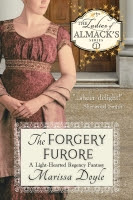Those of you who have read Would-Be Wilderness Wife may remember that the heroine, Catherine
Stanway, initially worked as a nurse for Doctor David Maynard. I didn’t make
him up. Doc Maynard was one of Seattle’s founding fathers, and, in my opinion,
one of the most colorful. I wish I had a picture to use, but all were
copyrighted. You can find one here at the Museum of History and Industry in
Seattle.
David Swinson Maynard came to Seattle in 1852, before it was
even a town, but his story starts on the other side of the country. After
earning his medical degree and marrying a pretty lass named Lydia, he moved his
young family to Cleveland, where he dabbled in business while running a medical
school. Misfortunes in both made him decide to strike it rich in California,
but he met two things along the way that would change his life.
The first was cholera. Everyone had it, and anyone who
survived after his treatment was more than happy to pay him in food, animals,
and money. He’d never made so much money being a doctor before. The second was
a widow of one of the men he unsuccessfully treated. Catherine Broshears was
beautiful and sweet, and he decided to accompany her to Olympia in what was
then Oregon Territory instead of the Gold Fields. Along the way the pair fell
in love, but her brother refused them permission to marry. It may have been the
fact that Maynard was so quick to fall into and out of fortunes. But it may
have had more to do with the fact that her brother suspected that the divorce
Maynard convinced the territorial legislature to grant him wasn’t strictly
legal.
Either way, Doc relocated to the Seattle area. He started
out paying the natives to package up wood and salmon to sell to folks in San
Francisco, then used that money to open a store. From there, he claimed a tract
of land for himself and his wife before convincing Catherine’s brother to let
him marry her. But that was just the beginning of Maynard’s influence on
Seattle:
- He convinced the settlers
to name the new town after his friend, Chief Sealth.
- He was the first Justice
of the Peace in King County, and even studied law, being admitted to the
bar in 1856.
- He is responsible for the
odd angle of downtown Seattle streets, because he plotted the streets on
his claim according to the compass points, while his neighbors insisted on
following the line of the shore.
- He was one of Seattle’s
first post masters, hosting the post office at his store (and guaranteeing
he’d have regular shoppers).
- He sold his lots cheaply
or gave them away to people he thought would be good for the city, such as
Henry Yesler, who built the first sawmill on Puget Sound, and Lewis
Wyckoff, a blacksmith and later one of Seattle’s first lawmen.
- He opened the first hospital in Seattle, an enterprise that failed because he insisted in treating whites and Native Americans alike, and he never demanded payment.
Perhaps one of the most famous stories about Maynard has to
do with his wives. It seems that Lydia was never told of the divorce and wrote
to him about her share of his acreage. Legalities being what they were, she had
to come to Seattle to be part of any settlement. According to historian Murray
Morgan, Doc went down to the shore to meet her when she came in on the ship. He
told a friend, “You’re about to see something you’ve never seen before: a man
out walking with a wife on each arm.” Seattle gawked as Maynard did just that.
Lydia stayed with him and Catherine for a while until the legal matters were
settled. Sadly, because Maynard had not been married to Catherine at the time
of filing, and Lydia had never lived on the claim as is required of a wife, he
had to give up half his acreage.
Doc still went out in style. When he died in 1873, Seattle held
the largest funeral for that time. And the stories of his exploits are still
told with fondness around the shores of Puget Sound.






No comments:
Post a Comment